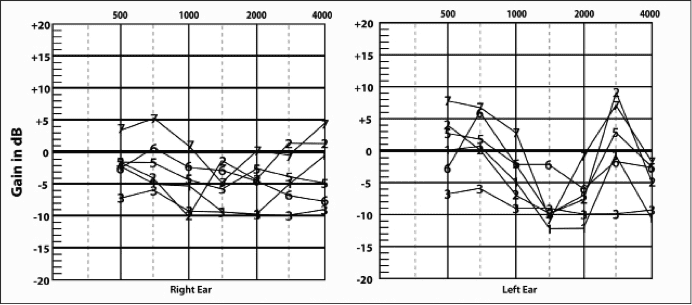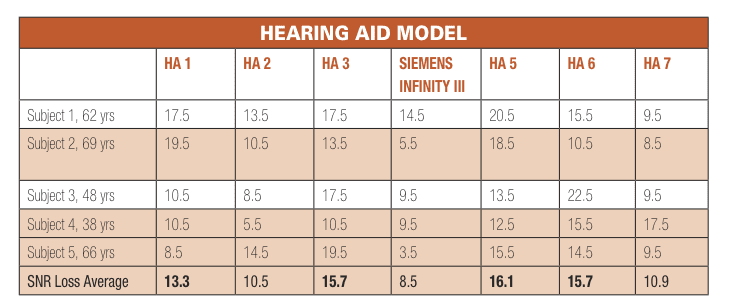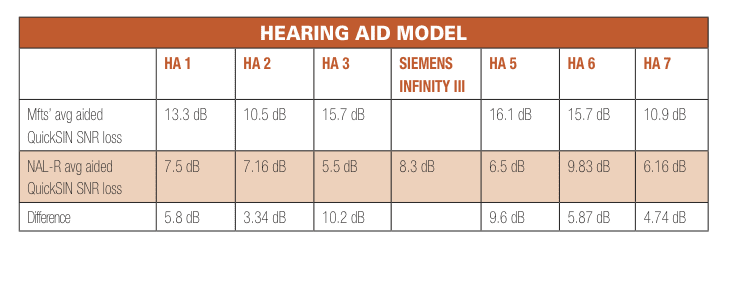By Ron J. Leavitt, AuD, and Carol Flexer, PhD
Reprogramming hearing aids from first-fit settings makes a huge positive impact
Lindley1 and Turner et al2 noted 80% of hearing aids sold in the United States are fit without real-ear verification. These findings were reinforced by Busen3 who showed similar findings in the state of Illinois. A more recent study by Mueller and Picou4 further confirmed the manufacturers’ first/best-fit algorithms currently form the foundation of contemporary hearing aid fittings in this country.5
The present study was designed to investigate the word-recognition scores in noise obtained on the Quick Speech in Noise Test (QuickSIN)6 when the manufacturers’ first-fit algorithms were employed in six pairs of the industry’s six largest manufacturers’ premium hearing aids.
For comparative purposes, word recognition scores on the QuickSIN also were measured using a pair of

|

|
| Ron J. Leavitt, AuD, owns a practice in Corvallis, Ore, and is the founder of the Oregon Association for Better Hearing (OABH), a nonprofit consumer test group for hearing aid users. Carol Flexer, PhD, is a distinguished professor emeritus of Audiology at the University of Akron and coauthor of the book Sound Field Amplification: Applications to Speech Perception and Classroom Acoustics. Correspondence can be addressed to Dr Leavitt at: [email protected] | |
10-year-old Siemens Infiniti III analog, single-channel, single-microphone behind-the-ear (BTE) hearing aids with no noise-reduction features, programmed to a best NAL-R fitting.7 An Audioscan RM 500 Real-Ear System was used to confirm an actual NAL-R fitting for these analog hearing aids.
Method
Subjects. Five long-time, twin-microphone, digital hearing aid wearers with sloping sensorineural hearing losses and an average age of 57 years (range: 39 to 69.5 years) participated in this investigation. The mean left and right audiogram with ±1 standard deviation error bars is displayed in Figure 1. These subjects were selected for their high-frequency auditory reserve, their high word recognition scores on the NU-6 monosyllabic word test in quiet, and their reported ability to function well in noisy environments with their current twin-microphone digital hearing aids.
The subjects were evaluated with the QuickSIN test under various hearing aid signal-processing schemes as provided by premium hearing aids and fitting software from the world’s six largest hearing aid manufacturers.
Procedures. Audiometric evaluations were conducted using the Carhart-Jerger adaptation of the Hughson-Westlake threshold procedure for all subjects prior to administration of the QuickSIN test.8,9 The subjects’ uncomfortable loudness levels (UCLs) were measured for puretones at 250, 500, 1000, 2000, 3000, and 4000 Hz using modified instructions recommended by Hawkins.10 No subject had an air-bone gap greater than 10 dB. All subjects had normal middle-ear function as measured by a GSI 33 middle-ear analyzer. All external auditory canals were clear as confirmed by video otoscopy immediately prior to audiometric and aided speech recognition testing. All subjects used their own custom acrylic or polyvinyl chloride earmolds under each aided condition with parallel vents approximately 2mm in diameter.

|
| Figure 1. Average puretone thresholds for right and left ears of 5 hard-of-hearing subjects. Bars represent ±1 SD. |
Hearing aids. The six largest manufacturers’ premium BTE hearing aids were used in this investigation. Except for the Siemens Infiniti III S-1 hearing aids, all were fully digital, twin-microphone, multi-channel hearing aids with a myriad of features including adaptive directionality, variable directionality across channels, automatic noise reduction employing modulation and/or format detection, active feedback suppression, acoustic scene analysis, datalogging, wireless connectivity, ear-to-ear communication, and multiple memories. Numerous compression strategies were used in these six pairs of hearing aids and the width of each channel’s filter skirts varied by manufacturer.
By contrast, the two Siemens Infiniti III S-1 aids used single-channel AGC-I and provided linear gain across frequencies for 40 dB SPL to 70 dB SPL inputs in a single channel up to the point of output limiting as verified by real-ear measures. These hearing aids were of a single-microphone design and employed analog sound processing. They were fit to best approximate an NAL-R fitting with 40 and 55 dB SPL inputs using an Audioscan RM 500 Real-Ear System to verify NAL-R was achieved. Proper limiting of high-intensity inputs was confirmed with an 80 dB SPL sweep-frequency puretone stimulus.
Speech recognition ability was assessed using the QuickSIN test at a 57 dB SPL presentation level in sound field. Logitech stereo loudspeakers were used for the QuickSIN sentence presentation. During testing, the subject was placed midway between the two loudspeakers at a 2 meter distance with the speakers placed at +45° azimuth to the subject. The floor of the test room was tile, and suspended sound-absorptive panels were placed on the ceiling. No sound-absorptive material was used on the sheet-rock walls. The QuickSIN CD was played on the CD drive of an E-Machine T5082 computer.
Seven lists of equivalent QuickSIN sentences were randomly chosen from the QuickSIN CD. The order of list presentation was randomized across subjects. Standardized QuickSIN instructions were read to each subject.
Each subject was fit with seven pairs of hearing aids in randomized order. Six pairs of premium digital hearing aids were set to the manufacturer’s prescribed “first/best fit” with appropriate subject and hearing aid use data entered into each manufacturer’s software.
With one set of hearing aids, the subjects’ threshold data were obtained while wearing the hearing aids using the procedure developed by the manufacturer. With another set of hearing aids, the manufacturer’s integrated real-ear fitting system was used to account for subjects’ individual ear characteristics.
The average comparative aided gain for sweep-frequency puretones presented at 55 dB SPL input is shown in Figure 2 for all analog and digital hearing aids. This method for reporting comparative gain was developed by Hawkins and Cook.11 In this case, this reporting method compares the NAL-R gain of the analog Siemens Infiniti III hearing aids to the gain of the other six premium hearing aids using the NAL-R gain as the “0” line. Stated differently, those hearing aids whose gain was greater than NAL-R at a given frequency are shown as positive values above the “0” line and those whose gain was less than NAL-R are shown below the “0” line.
The aided articulation index (AI) scores are reported in Table 1 for all seven pairs of hearing aids using the American National Standards Institute (ANSI) procedure.12
The order of hearing aids tested was randomized for each subject, and the subjects were blinded as to which hearing aids they were testing. No hearing aid required “fine-tuning” due to feedback. Thus, all hearing aids, except the Siemens Infiniti III S-1, used the default fitting recommended by the manufacturer’s software.
Results
The individual QuickSIN scores and averaged data are shown in Table 2. The average T-scores that are significantly poorer than the Siemens Infinity III S-1 hearing aid scores at the .95 level of confidence are shown in bold type. It is apparent that superior scores on the QuickSIN were obtained with the Siemens Infiniti III S-1 analog hearing aids (8.5 dB mean SNR loss). In the worst case scenario, Hearing Aids 3, 5, and 6—when set to the manufacturer’s prescribed settings—required approximately 8 dB of noise reduction on the QuickSIN test before subjects could perform comparably with these newer top-of-the-line hearing aids. Further, no premium digital hearing aid set to the manufacturer’s first-fit consistently outperformed the 10-year-old analog Infiniti III aids.
Examination of the data in Table 1 shows that the higher binaural aided AI scores produced better SNR loss values on the QuickSIN. The myriad of features these premium digital hearing aids provided could not compensate for insufficient audibility of speech.
Six months later, all 6 pairs of fully digital hearing aids were reprogrammed to an NAL-R target for 40 and 55 dB SPL sweep-frequency puretones using the same Audioscan RM 500 real-ear system with subjects seated in the same room in the same position. QuickSIN scores were again obtained at 57 dB SPL in soundfield for these five subjects in a single-blinded, randomized order of presentation. Those results are shown in Table 3 with side-by-side comparison of the previous SNR loss values obtained from the manufacturer’s first-fit algorithm for the same hearing aids, same subjects, and same test conditions.
On average, the programming changes made to alter the manufacturer’s first-fit to an NAL-R target resulted in an average 6.6 dB SNR loss improvement across manufacturers—which is a significant improvement at the .95 level of confidence. Further, two sets of the worst-performing digital hearing aids set to the manufacturers’ first-fit became two of the best-performing digital hearing aids when these programming changes were made.
It might be argued that the observed QuickSIN score differences among hearing aid pairs were a combination of programming algorithms and the myriad of performance features available on these digital hearing aid pairs. We disagree. When all the digital hearing aids were set to NAL-R for sweep-frequency puretones, the QuickSIN scores were equivalent. Whether that performance similarity would maintain with other speech-in-noise tests and other real-ear stimuli remains unknown.
Discussion
Based on these results, the following observations are offered:
1) For these subjects, the manufacturers’ first/best-fit algorithms in these premium hearing aids are not providing the best possible word recognition in noise scores as measured by the QuickSIN test.
2) Manufacturers’ attempts to account for individual ear variability by obtaining thresholds through the hearing aid or using an integrated real-ear system built into the hearing aid did not yield significantly better scores on the QuickSIN for these subjects. The inability of hearing aid manufacturers to account for individual ear variability has been further reinforced by the data of DiGiovanni and Pratt.13
3) Manufacturers’ first-fit algorithms provided inconsistent real-ear aided speech audibility both within subjects and across subjects. Specifically, subjects with symmetrical hearing losses did not receive equivalent real-ear gain between ears. Additionally, while one subject might receive a high real-ear aided speech audibility rating with one set of hearing aids, another subject with similar hearing loss may receive much lower speech audibility ratings with the same hearing aids.
4) Even though all subjects had gently sloping, high-frequency hearing losses, no manufacturer’s fitting provided gently sloping, gradually increasing, high-frequency real-ear aided gain for sweep frequency puretones.
5) Previous claims that today’s contemporary hearing aids set to the manufacturers’ first-fit can provide speech recognition in noise equivalent to normal-hearing listeners are not supported by these data.
6) After reprogramming the six pairs of fully digital hearing aids to an NAL-R target, there was only a 4.3 dB SNR difference between the best performing and worst performing hearing aids in this study on the QuickSIN test. The NAL-R reprogrammed hearing aids (#6 in Table 3) that provided the worst performance on the QuickSIN for these five subjects had insufficient gain to achieve the NAL-R target. If these hearing aids were eliminated from the comparison, the largest difference between the best- and worst-performing hearing aids is a non-significant 2 dB SNR loss.
Conclusion
Our data suggest that, for these five subjects, today’s advanced hearing aids programmed to the manufacturers’ first-fit do not yield the best possible QuickSIN scores. Further, manufacturers’ attempts to account for individual ear variability did not significantly improve QuickSIN scores for these subjects.
However, setting these same premium hearing aids to an NAL-R target for 40 and 55 dB SPL sweep frequency puretones did significantly improve scores on the QuickSIN for these five subjects. Once set to an NAL-R target, 5 of the 6 pairs of premium hearing aids yielded improved and equivalent QuickSIN scores. In no instance did increasing speech cue audibility to an NAL-R target on these premium hearing aids decrease any of the five subjects’ QuickSIN scores.
References
1. Lindley G. Current hearing aid fitting protocols: results from an online survey. Audiology Today. 2006;18(3):19-22.
2. Turner RG, Palmer CV, Mueller HG. Hearing aid research: 2008 in review. Presentation at: 2009 Annual American Academy of Audiology Conference; Dallas, Tex; 2009.
3. Busen J. Probe-microphone measurements: commonly used or neglected? Proceedings of the 2010 Annual American Academy of Audiology Conference; San Diego; 2010.
4. Mueller HG, Picou EM. Survey examines popularity of real-ear probe-microphone measures. Hear Jour. 2010;63(5):27-32.
5. Strom KE. CR shows us great opportunity. Hearing Review. 2009;16(7):8.
6. Killion MC, Niquette PA, Gudmundsen GI, Revit LJ, Banerjee S. Development of a quick speech-in-noise test for measuring signal-to-noise ratio loss in normal-hearing and hearing-impaired listeners. J Acoust Soc Am. 2004;116:2395–2405.
7. Byrne D, Dillon H. The National Acoustics Laboratories’ new procedure for selecting gain and frequency response of a hearing aid. Ear Hear. 1986;7(4):257-265.
8. Hughson W, Westlake H. Manual for program outline for rehabilitation of aural casualties both military and civilian. Trans Am Acad Ophthal mol Otolaryngol; 1944;[Suppl]48:1-15.
9. Carhart R, Jerger J. Preferred method for clinical determination of pure-tone thresholds. J Speech Hear Lang Res. 1959;24(4):330-345.
10. Hawkins DB. Loudness discomfort levels: a clinical procedure for hearing aid evaluations. J Speech Hear Disord. 1980;45:3-15.
11. Hawkins DB, Cook JA. Hearing aid software predicted gain values: how accurate are they? Hear Jour. 2003;56(7):26,28,32,34.
12. American National Standards Institute (ANSI). American national standard methods for the calculation of the articulation index [ANSI S3.5-1969 R 1986]. New York: ANSI.
13. DiGiovanni JJ, Pratt RM. Verification of in situ thresholds and integrated real-ear measurements. J Am Acad Audiol. 2010;21:663-670.









